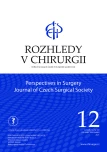Transhepatic perforation of the gallbladder with massive intraperitoneal hemorrhage as a rare complication of acute cholecystitis
Authors:
Ch. Mach; J. Moláček; T. Skalický; V. Třeška
Authors‘ workplace:
Chirurgická klinika, Fakultní nemocnice Plzeň a lékařská fakulta Univerzity Karlovy v Plzni
Published in:
Rozhl. Chir., 2021, roč. 100, č. 12, s. 603-606.
Category:
Case Report
doi:
https://doi.org/10.33699/PIS.2021.100.12.603–606
Overview
Introduction: Perforation of the gallbladder into the hepatic parenchyma with massive bleeding into the abdominal cavity is a very rare but life-threatening complication of acute cholecystitis. Initially, the clinical finding may not differ significantly from the normal course of acute cholecystitis, but later there is a significant deterioration associated with hemorrhagic shock. Monitoring of the patient’s clinical condition as well as radiological methods have a crucial role in early and accurate diagnosis.
Case report: We present the case of a 55-year-old patient who was admitted to our clinic with the clinical finding of acute cholecystitis. During the third day of hospitalization, there was a significant deterioration in his clinical condition with circulatory instability. Computed tomography (CT) scans revealed massive hemoperitoneum with a large hematoma reaching into the liver parenchyma and the gallbladder bed. Based on this finding, the patient was indicated for urgent laparotomy. The perioperative finding confirmed intrahepatic perforation of the gallbladder with a stone collapsed into the hepatic parenchyma and secondary perforation of the hepatic capsule with massive bleeding into the abdominal cavity. The authors present an unusual complication of acute cholecystitis, its diagnosis and surgical solution.
Conclusion: Massive intraperitoneal bleeding associated with transhepatic perforation of the gallbladder is very rare, occurring only in single-digit percent of acute cholecystitis cases. It is essential to evaluate not only the clinical and laboratory findings, but above all to complete an appropriate imaging assessment. The timing of the assessment is crucial for proper preoperative diagnosis and for reducing the risks of urgent surgical treatment.
Keywords:
acute cholecystitis − subcapsular hematoma of the liver − hemoperitoneum − gallbladder perforation
Sources
1. Stefanidis D, Sirinek KR, Bingener J. Gallbladder perforation: risk factors and outcome. J Surg Res. 2006 Apr;131(2):204−208. doi:10.1016/j.jss.2005.11.580.
2. Nural MS, Bakan S, Bayrak IK, et al. A rare complication of acute cholecystitis: transhepatic perforation associated with massive intraperitoneal hemorrhage. Emerg Radiol. 2007 Nov;14(6):439−441. doi:10.1007/s10140-007-0621-1.
3. Derici H, Kara C, Bozdag AD, et al. Diagnosis and treatment of gallbladder perforation. World J Gastroenterol. 2006 Dec 28;12(48):7832−7836. doi:10.3748/wjg. v12.i48.7832.
4. Kolder D, Geiger T, Tharakan AK, et al. Massive hemoperitoneum from transhepatic perforation of the gallbladder. Mt Sinai J Med. 2006 Dec;73(8):1135−1136.
5. Menakuru SR, Kaman L, Behera A, et al. Current management of gall bladder perforations. ANZ J Surg. 2004 Oct;74(10):843−846. doi:10.1111/j.1445 - 1433.2004.03186.x.
6. Kim YC, Park MS, Chung YE, et al. Gallstone spillage caused by spontaneously perforated hemorrhagic cholecystitis. World J Gastroenterol. 2007 Nov 7;13(41):5525−5526. doi:10.3748/wjg.v13.i41.5525.
7. Sood BP, Kalra N, Gupta S, et al. Role of sonography in the diagnosis of gallbladder perforation. J Clin Ultrasound. 2002 Jun;30(5):270−274. doi:10.1002/ jcu.10071.
8. Bennett GL, Balthazar EJ. Ultrasound and CT evaluation of emergent gallbladder pathology. Radiol Clin North Am. 2003 Nov;41(6):1203−1216. doi:10.1016/ s0033-8389(03)00097-6.
9. Tavernaraki K, Sykara A, Tavernaraki E, et al. Massive intraperitoneal bleeding due to hemorrhagic cholecystitis and gallbladder rupture: CT findings. Abdom Imaging. 2011 Oct;36(5):565−568. doi:10.1007/s00261-010-9672-y.
10. Sládeček P, Štefka J, Gürlich R. Načasování cholecystektomie v terapii akutní kalkulózní cholecystitidy. Rozhl Chir. 2019;98(12):492–496. doi:10.33699/PIS. 2019.98.12.492–496.
11. Palomba G, Dinuzzi VP, Amendola A, et al. Laparoscopic cholecystectomy for acute cholecystitis: onset of symptoms and severity grade as a tool for choosing the optimal timing. Minerva Surg. 2021 Apr 23. Online ahead of print. doi:10.23736/ S2724-5691.21.08511-4.
Labels
Surgery Orthopaedics Trauma surgeryArticle was published in
Perspectives in Surgery

2021 Issue 12
- Metamizole vs. Tramadol in Postoperative Analgesia
- Metamizole at a Glance and in Practice – Effective Non-Opioid Analgesic for All Ages
- Metamizole in perioperative treatment in children under 14 years – results of a questionnaire survey from practice
Most read in this issue
- Retroperitoneal hematoma: diagnosis and treatment
- Laparoscopic versus open elective right hemicolectomy with curative intent for colon adenocarcinoma
- Video-assisted and robotic-assisted thoracoscopic pulmonary lobectomies, our experience
- Tumor mimicking gastric ulcer penetrating asymptomatically into the pancreas
